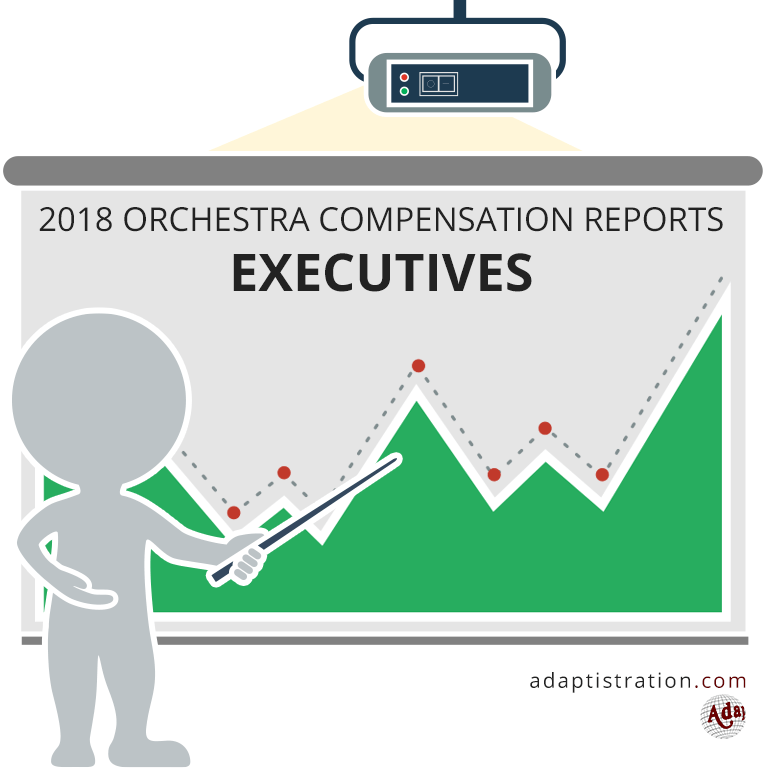When it comes to executive compensation, the 2015/16 season was one were average figures were skewed by a larger than normal number of CEO vacancies and interim appointments among the higher paying positions. But even then, the average executive compensation increased by just over one percent.
The Information
In order to provide information that is as accurate as possible, info from the 2015/16 season is gathered from the following sources:
- Executive compensation figures were obtained from their respective orchestra’s IRS Form 990 for the 2015/16 concert season.
- Total Expenditures were also obtained from each respective orchestra’s IRS Form 990 for the 2015/16 concert season (due to their relationship within a larger performing arts structure, Total Expenditure figures for National Symphony, Atlanta Symphony, and Dayton Philharmonic are not as readily available).
Adaptistration makes no claim to the accuracy of information from documents compiled or reported by external sources. If you have reason to believe any of the information is inaccurate or has changed since reported in any of the above sources and you can provide documentation to such effect, please feel free to use the following form to submit a notice.
Did you know? Direct links to most of the orchestra’s financial disclosure documents at guidestar.org are available in the Orchestra Financial Reports.
What The Numbers Don’t Show
It is important to remember that the numbers shown do not always convey a complete compensation picture. For example, an executive director may have had a large increase in salary due to a severance or deferred compensation package owed when the position was vacated. Additionally, the documents used to gather figures do not indicate how much of the season an individual received a salary. As such, the cumulative compensation may artificially inflate annual earnings.
Conversely, reported figures may not reflect bonuses or other incentive payments, therefore underreporting what executives may actually earn. As such, the cumulative compensation executives may differ from what is listed.
If you’re curious about exactly how much of a difference can exist, the Philadelphia Orchestra bankruptcy proceeding shed a sliver of light onto the river of unspecified compensation executives can garner by way of perks and benefits. Details were reported in an article published on 3/2/2012.
For additional details about any individual executive’s compensation in any given season, you should review the corresponding IRS Form 990 for any statements, notes, and/or addendums provided by the organization to explain compensation abnormalities.
2015/16 Season Executive Compensation
Sorry, but this information is only made available for one year until the following season’s reports are published. Copies are available for a fee (feel free to inquire), or you can begin compiling your own database by building a comprehensive library of orchestra 990s, available from the Adaptistration Store.
Top 10 Earners
- Los Angeles Philharmonic: $1,579,971
- Boston Symphony: $831,728
- Philadelphia Orchestra: $802,840
- New York Philharmonic: $728,345
- Chicago Symphony: $615,035
- San Francisco Symphony: $590,524
- Dallas Symphony: $500,763
- Cincinnati Symphony: $479,620
- Seattle Symphony: $470,993
- Houston Symphony: $449,472

Items Of Note
In addition to the larger than normal number of vacancies at the higher end of the pay scale, 12 out of 65 orchestras in the 2018 review did not have an executive who served a full season or had an interim CEO. That’s the largest number of gaps in a single season since we started tracking the figures in the 1999/00 season.
In last year’s report we saw one of the largest golden parachutes the field has seen in the form of Minnesota Orchestra paying their outgoing President & CEO, Michael Henson, a whopping $1,048,686 total compensation package.
That payout included $404,987 paid as “Other Reportable Compensation,” which can be reasonably deduced as part of his overall severance package.
As it turns out, that was just the beginning.
According to the Minnesota Orchestra’s 2015/16 filing, the organization paid Henson an additional $546,703. Schedule J, Part II, B.iii. lists $523,483 as “Other Reportable Compensation” plus an additional $22,220 reported in Column D as nontaxable benefits.

Apparently, the $404,987 from 2014/15 was just the backup chute.


